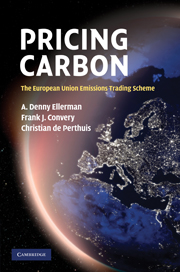Book contents
- Frontmatter
- Contents
- List of figures
- List of tables
- List of boxes
- List of appendices
- Frequently used abbreviations
- Preface
- 1 Introduction
- 2 Origins and development of the EU ETS
- 3 Allowance allocation
- 4 Effects of free allocation
- 5 Market development
- 6 Emissions abatement
- 7 Industrial competitiveness
- 8 Costs
- 9 Linkage and global implications
- 10 Conclusions
- Annex: The interaction between the EU ETS and European electricity markets
- Appendix A Sequence of events in the development of the EU ETS and Linking Directives
- Appendix B Data tables
- Bibliography
- Index
9 - Linkage and global implications
Published online by Cambridge University Press: 05 July 2011
- Frontmatter
- Contents
- List of figures
- List of tables
- List of boxes
- List of appendices
- Frequently used abbreviations
- Preface
- 1 Introduction
- 2 Origins and development of the EU ETS
- 3 Allowance allocation
- 4 Effects of free allocation
- 5 Market development
- 6 Emissions abatement
- 7 Industrial competitiveness
- 8 Costs
- 9 Linkage and global implications
- 10 Conclusions
- Annex: The interaction between the EU ETS and European electricity markets
- Appendix A Sequence of events in the development of the EU ETS and Linking Directives
- Appendix B Data tables
- Bibliography
- Index
Summary
Introduction
At its launch in 2005 the EU ETS covered approximately 40 per cent of all European Union greenhouse gas emissions through caps on CO2 emissions from energy-intensive sectors in the then twenty-five member states. It did not limit non-CO2 emissions from the ETS sectors, nor did it regulate emissions from agriculture, housing, waste management or transportation. Nevertheless, the emissions initially covered by the ETS represented 11 per cent of emissions from developed nations and 4 per cent of emissions worldwide.
In order to enhance its environmental impact and its cost-effectiveness over time, the EU ETS was designed to be enlarged. The directive establishing the scheme included provisions to extend the programme's coverage by enabling member states to add further installations, economic sectors and non-CO2 gases (the opt-in). Additionally, the linking directive established a connection between the EU ETS and the Kyoto Protocol. This provision not only gave EU ETS participants permission to use Kyoto project credits for their compliance, but also outlined a framework by which the EU ETS could connect directly with cap-and-trade programmes in nations not covered by the scheme.
To date, the discussion of how the EU ETS might link with other nations has been largely normative. This chapter seeks to provide empirical evidence of how these links have been achieved in practice, and how the scope of the trading scheme was enlarged during the trial period.
- Type
- Chapter
- Information
- Pricing CarbonThe European Union Emissions Trading Scheme, pp. 260 - 286Publisher: Cambridge University PressPrint publication year: 2010



